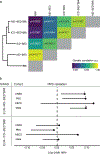Genome-wide analysis of a model-derived binge eating disorder phenotype identifies risk loci and implicates iron metabolism
- PMID: 37550530
- PMCID: PMC10947608
- DOI: 10.1038/s41588-023-01464-1
Genome-wide analysis of a model-derived binge eating disorder phenotype identifies risk loci and implicates iron metabolism
Abstract
Binge eating disorder (BED) is the most common eating disorder, yet its genetic architecture remains largely unknown. Studying BED is challenging because it is often comorbid with obesity, a common and highly polygenic trait, and it is underdiagnosed in biobank data sets. To address this limitation, we apply a supervised machine-learning approach (using 822 cases of individuals diagnosed with BED) to estimate the probability of each individual having BED based on electronic medical records from the Million Veteran Program. We perform a genome-wide association study of individuals of African (n = 77,574) and European (n = 285,138) ancestry while controlling for body mass index to identify three independent loci near the HFE, MCHR2 and LRP11 genes and suggest APOE as a risk gene for BED. We identify shared heritability between BED and several neuropsychiatric traits, and implicate iron metabolism in the pathophysiology of BED. Overall, our findings provide insights into the genetics underlying BED and suggest directions for future translational research.
© 2023. The Author(s), under exclusive licence to Springer Nature America, Inc.
Conflict of interest statement
Competing Interests Statement
Dr. Hildebrandt is a scientific advisory board member of Noom, Inc. and Drs. Hildebrandt and Sysko receive funding from and have equity in Noom, Inc. (non-publicly traded company). Dr. Sysko receives royalties from Wolters Kluwer Health.
Figures





References
-
- Reichborn-Kjennerud T, Bulik CM, Tambs K & Harris JR Genetic and environmental influences on binge eating in the absence of compensatory behaviors: a population-based twin study. Int. J. Eat. Disord. 36, 307–314 (2004). - PubMed
-
- Wonderlich SA, Gordon KH, Mitchell JE, Crosby RD & Engel SG The validity and clinical utility of binge eating disorder. Int. J. Eat. Disord. 42, 687–705 (2009). - PubMed
Methods-only references
Publication types
MeSH terms
Substances
Grants and funding
- U01 DA041120/DA/NIDA NIH HHS/United States
- U01 DA041093/DA/NIDA NIH HHS/United States
- I01 BX004189/BX/BLRD VA/United States
- U24 DA041123/DA/NIDA NIH HHS/United States
- RC2 MH089924/MH/NIMH NIH HHS/United States
- R01 AG067025/AG/NIA NIH HHS/United States
- U01 DA041117/DA/NIDA NIH HHS/United States
- U01 DA041148/DA/NIDA NIH HHS/United States
- R01 MH125246/MH/NIMH NIH HHS/United States
- RC2 MH089983/MH/NIMH NIH HHS/United States
- U24 DA041147/DA/NIDA NIH HHS/United States
- U01 MH116442/MH/NIMH NIH HHS/United States
- U01 DA041134/DA/NIDA NIH HHS/United States
- U01 DA041022/DA/NIDA NIH HHS/United States
- S10 OD026880/OD/NIH HHS/United States
- R01 MH109677/MH/NIMH NIH HHS/United States
- T32 MH122394/MH/NIMH NIH HHS/United States
- U01 DA041156/DA/NIDA NIH HHS/United States
- U01 DA041025/DA/NIDA NIH HHS/United States
- T32 MH087004/MH/NIMH NIH HHS/United States
- U01 DA041089/DA/NIDA NIH HHS/United States
- I01 BX002395/BX/BLRD VA/United States
- U01 DA041106/DA/NIDA NIH HHS/United States
- L40 MH127664/MH/NIMH NIH HHS/United States
- T32 MH096679/MH/NIMH NIH HHS/United States
- S10 OD030463/OD/NIH HHS/United States
- U01 DA041028/DA/NIDA NIH HHS/United States
- U01 DA041048/DA/NIDA NIH HHS/United States
- U01 DA041174/DA/NIDA NIH HHS/United States
- K08 MH122911/MH/NIMH NIH HHS/United States
LinkOut - more resources
Full Text Sources
Miscellaneous

